Pasta Al Pesto (Linguine With Basil Pesto)
This vegan pasta al pesto is ready in 20 minutes and is a perfect and simple Italian dish. The homemade basil pesto is served with linguine pasta resulting in a classic pasta recipe that packs a punch of flavor with fresh basil, crunchy pine nuts, and garlic.
Type: main
Cuisine: Italian
Keywords: pasta, pesto, italian, basil,
Recipe Yield: 2
Calories: 974
Preparation Time: 5
Cooking Time: 15
Total Time: 20
Recipe Video Name: Pasta Al Pesto (Linguine With Basil Pesto)
Recipe Video Description: This vegan pasta al pesto is ready in 20 minutes and is a perfect and simple Italian dish. The homemade basil pesto is served with linguine pasta resulting in a classic pasta recipe that packs a punch of flavor with fresh basil, crunchy pine nuts, and garlic.
Recipe Ingredients:
- 7 oz. (200 gr) linguine pasta
- 1 tsp salt (to boil the linguine with)
- ~ ½ cup (60 gr) pine nuts
- 2 cups (45 gr) loosely packed fresh basil leaves
- 1 clove of garlic, minced
- 2 tbsp (18 gr) nutritional yeast
- 1/4 tsp salt
- 1/4 tsp pepper
- ~ 1 1/4 tbsp (20 gr) vegan Parmesan cheese
- 6 tbsp (90 ml) extra-virgin olive oil
Recipe Instructions: Bring a large pot of water with salt to a boil. Cook the linguine according to the package instructions until it is al dente. Reserve 1/4 cup of pasta water. Drain the pasta and set it aside (you can return it to the same pot). Add the pine nuts to a dry pan and roast until most of the pine nuts turn brown. Keep an eye on the pan, as pine nuts tend to burn quickly. Give the pan a shake often to prevent the pine nuts from burning. While the pasta is cooking, make the pesto. In a food processor, pulse together basil, garlic, pine nuts, nutritional yeast, vegan Parmesan cheese, salt, and pepper until it is semi-smooth. Blend the ingredients until they are well combined, and slowly add the olive oil. If the pesto is too thick and dry, add a little pasta water to thin it out. It should be smooth with a bit of texture. Add the pesto to the pot with cooked linguine and toss until the pasta is evenly coated. If the pasta seems dry, add a little of the reserved pasta water, a tablespoon at a time, until the desired consistency is reached. Taste the pesto before serving and adjust the seasoning according to your taste. You may need to add more salt or pepper to enhance the flavors. Serve the pesto pasta immediately, garnished with basil leaves, nutritional yeast (or vegan Parmesan cheese), and a sprinkle of black pepper, if desired.
5
This vegan pasta al pesto is ready in 20 minutes and is a perfect and simple Italian dish. The homemade basil pesto is served with linguine pasta resulting in a classic pasta recipe that packs a punch of flavor with fresh basil, crunchy pine nuts, and garlic.
THE ORIGINS OF PASTA AL PESTO
Pasta al Pesto is a pasta dish with its roots in Italy’s Liguria region. The sauce, made with fresh basil, garlic, pine nuts, Parmesan, and olive oil, is the epitome of traditional Italian cuisine.
This classic recipe is a popular main course, a delectable side dish, or a refreshing cold pasta salad.
Pasta al Pesto is usually made with linguine, a pasta with a flat and narrow appearance reminiscent of spaghetti. The name “linguine” is derived from the Italian term for “little tongues,” fittingly describing its shape. If you want to read more on this pasta variety, I can recommend this article.
WHY YOU WILL LOVE THIS PASTA RECIPE
Besides the delicious flavors and a fool-proof recipe, you will love this pasta because:
- It makes a perfect dish for a quick weeknight dinner or to impress at a dinner party.
- All you need is a blender or food processor and it’s ready to be served in 20 minutes.
- A fool-proof and easy recipe made with fresh ingredients.
- If you wish, you can make this dish gluten-free.
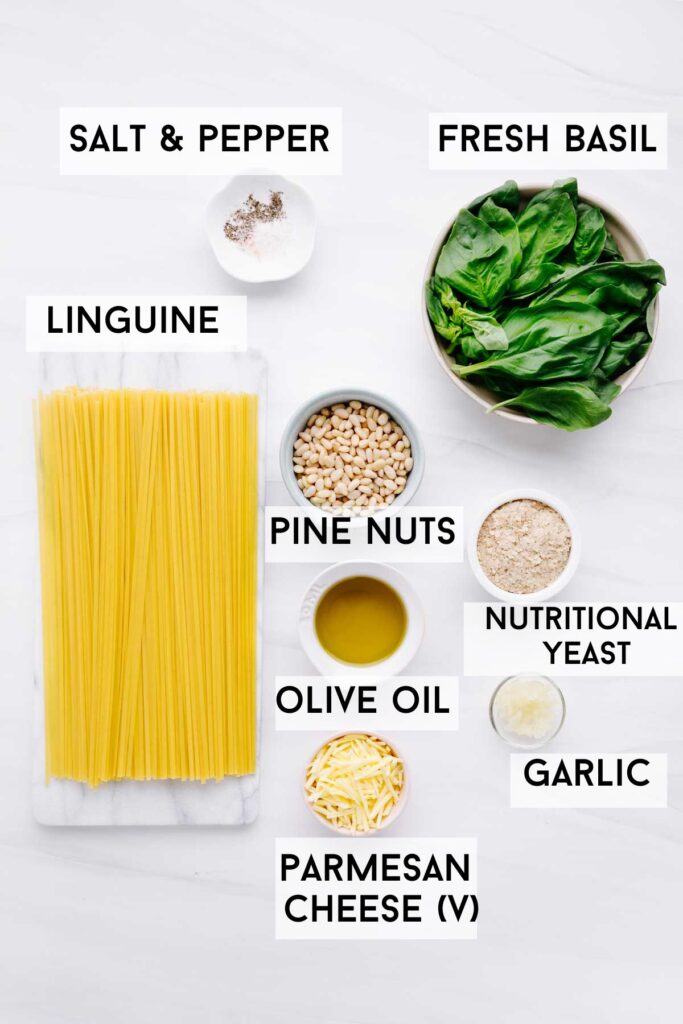
INGREDIENT NOTES
Linguine pasta
Linguine is a pasta variation with a flat, wider shape and it is designed to hold onto every delicious drop of pesto. And for those who are gluten-free or have sensitivities – you can still enjoy this dish made with alternative flours like corn, rice, or wheat.
Pine nuts
Pine nuts are traditionally used in pesto and add a slightly crunchy texture and a rich, nutty flavor to the dish.
Fresh basil leaves
Regular sweet basil (not Thai basil) is a key ingredient in traditional pesto and provides a fresh, herby flavor.
Minced garlic
Garlic adds a nice pungent aroma and a slightly spicy taste to the dish.
Nutritional yeast
Nutritional yeast is vegan and adds a savory, cheesy flavor to the dish, and it serves as a replacement for Parmesan cheese used in basil pesto.
High-quality olive oil
Olive oil binds the ingredients together and creates a smooth and creamy texture for the pesto. Use high-quality extra-virgin olive oil for the best taste.
Salt & pepper
Salt is used to bring out the flavors of the other ingredients, while pepper adds a nice spiciness and a little bit of heat.
Vegan Parmesan cheese (optional)
Vegan Parmesan cheese is used as a dairy-free alternative to traditional Parmesan cheese. It adds saltiness and creaminess to the dish. This is an optional ingredient, so if you prefer, you can leave it out or substitute it with more nutritional yeast.
HOW TO MAKE PASTA AL PESTO (STEP-BY-STEP WITH PHOTOS)
While this dish is traditionally made with a mortar and pestle to pound the ingredients, we are going to make things easier by using a food processor.
Step 1 – cook the pasta
Bring a large pot of salted water to a boil. Cook the pasta until it is al dente. Reserve 1/4 cup of pasta water.
Step 2– drain the pasta
Drain the pasta and set it aside (you can use the same pot).
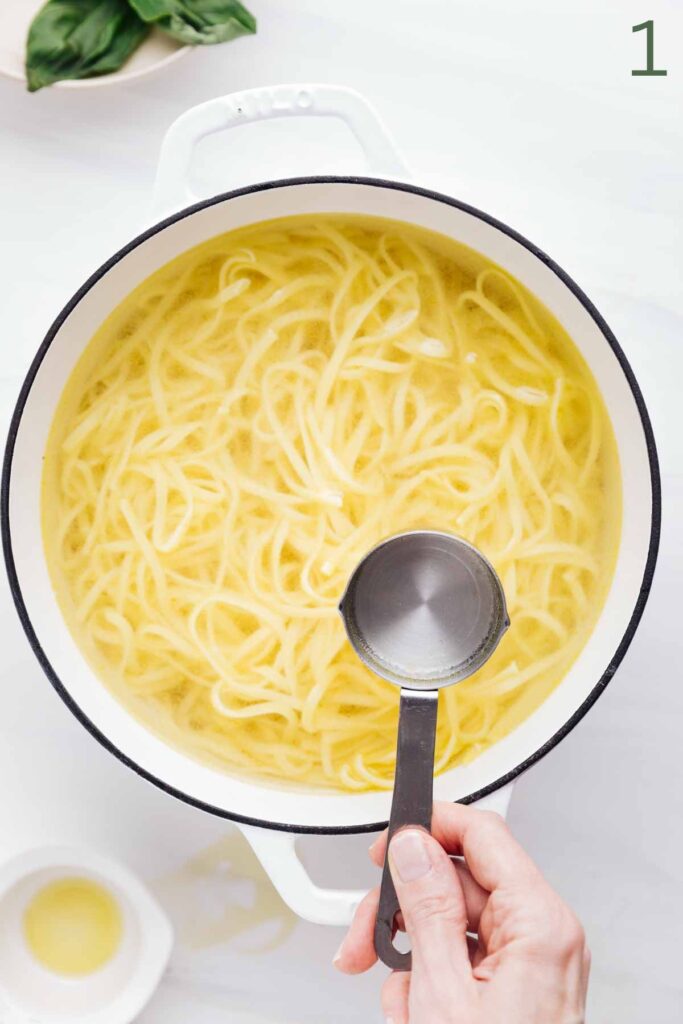
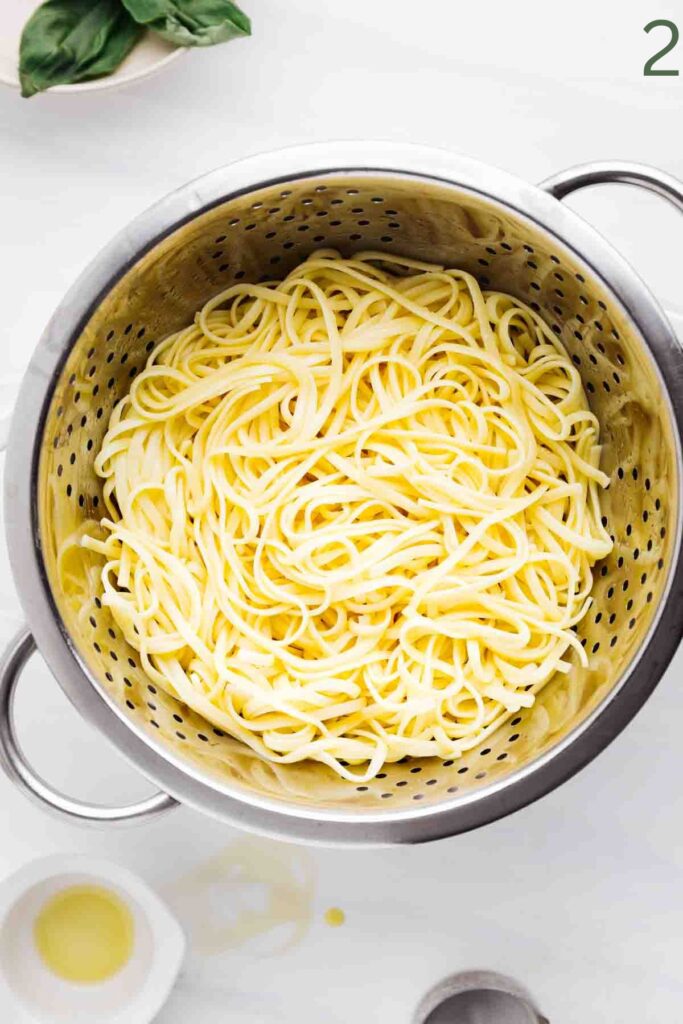
Step 3 – make the basil pesto
While the pasta is cooking, make the pesto. Start by gently roasting the pine nuts.
Step 4
Next, to a food processor, add the fresh basil.
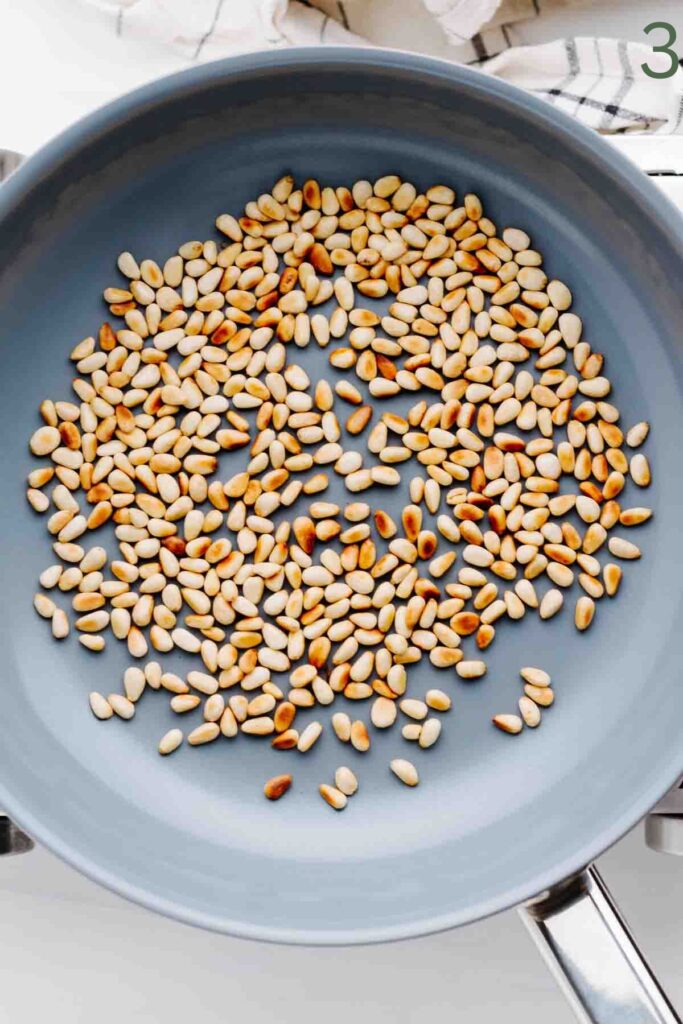
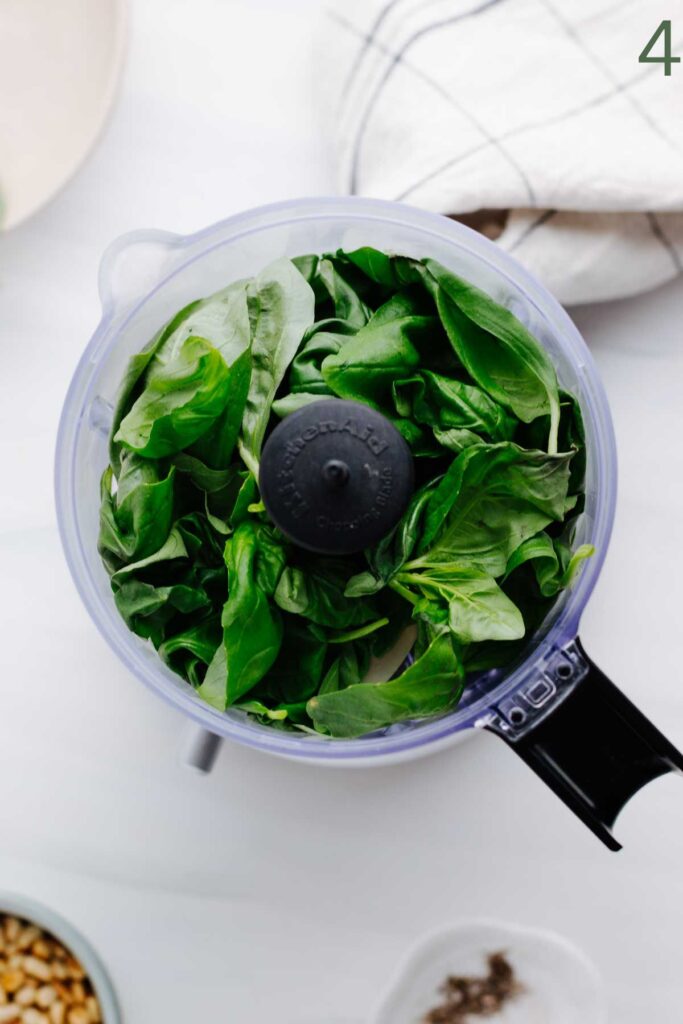
Step 5
Followed by the other ingredients: basil, garlic, pine nuts, nutritional yeast, olive oil, salt, and pepper.
Step 6
In a food processor, mix until smooth and slowly add the olive oil.
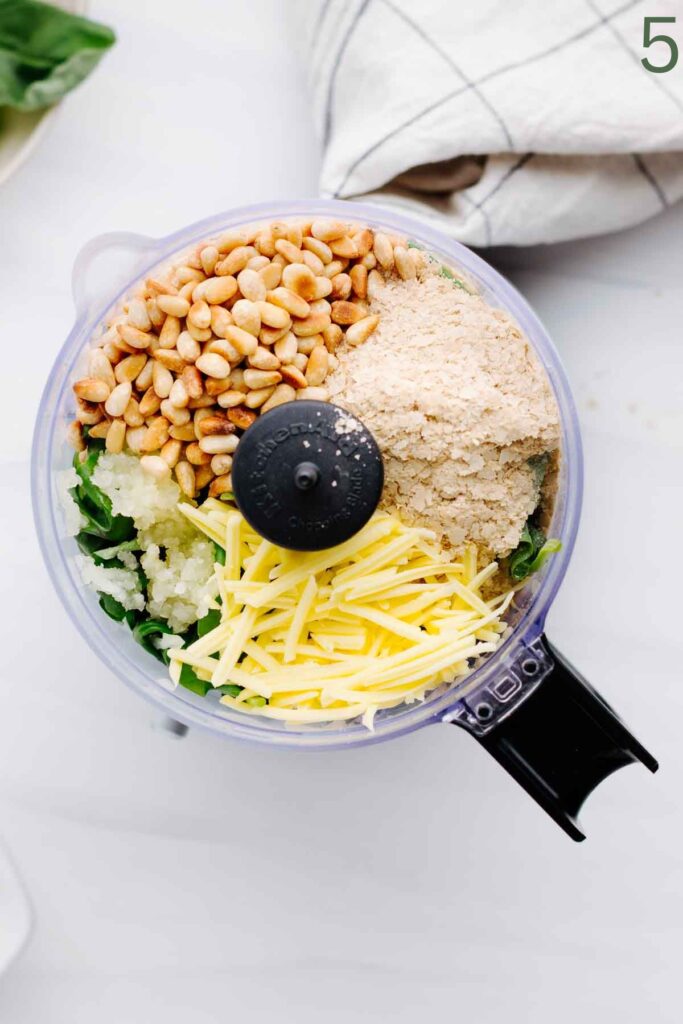
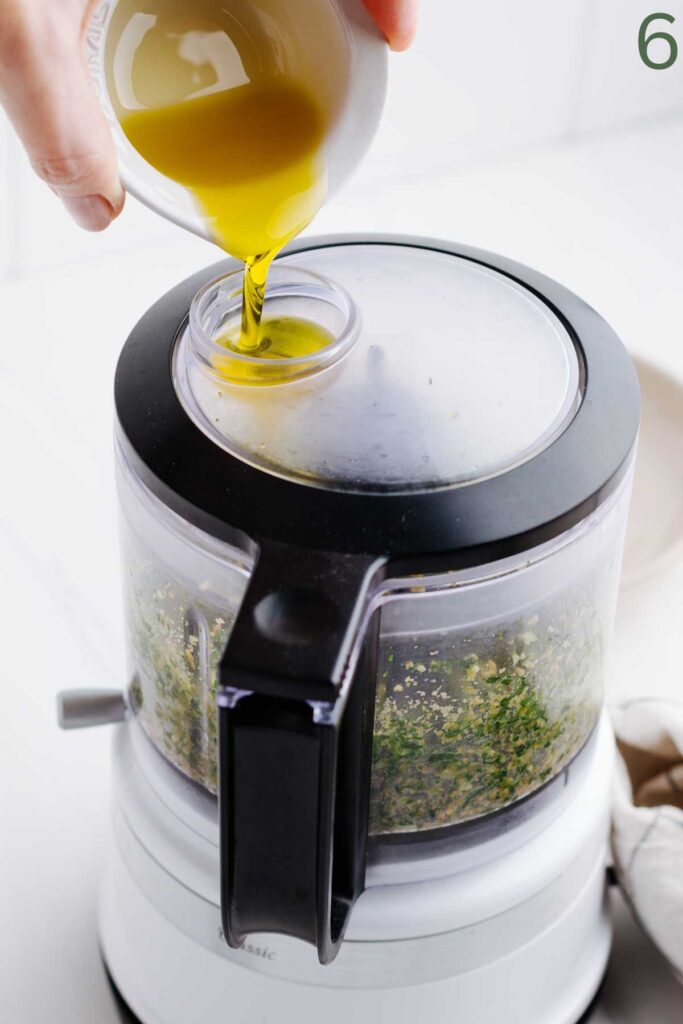
Step 7
If the pesto is too thick, add a little pasta water to thin it out.
Step 8
It should be smooth with a bit of texture.
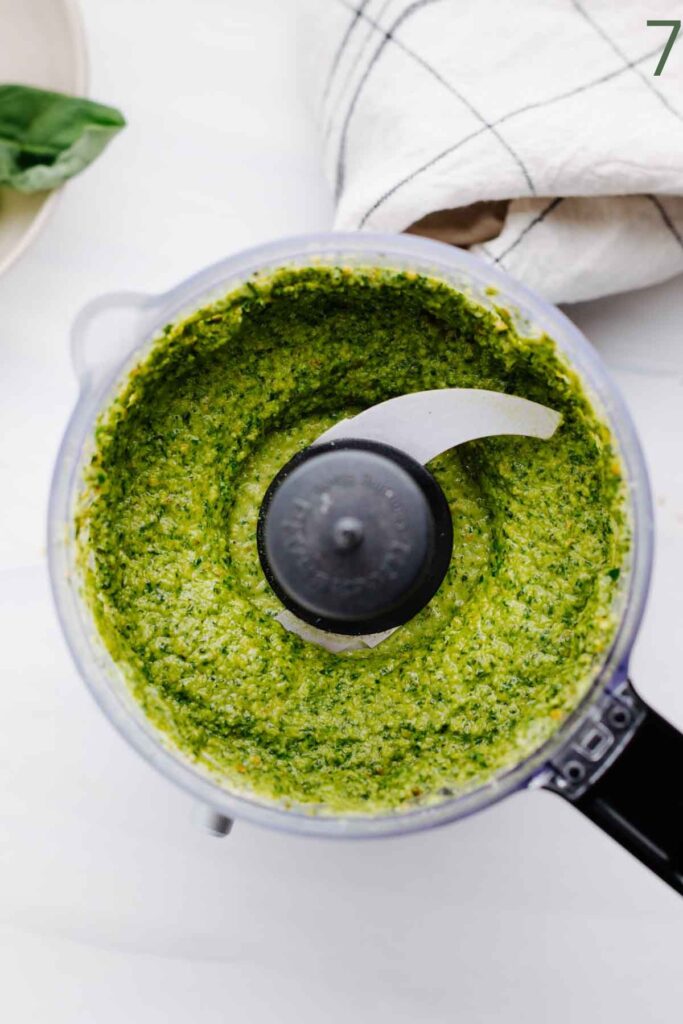
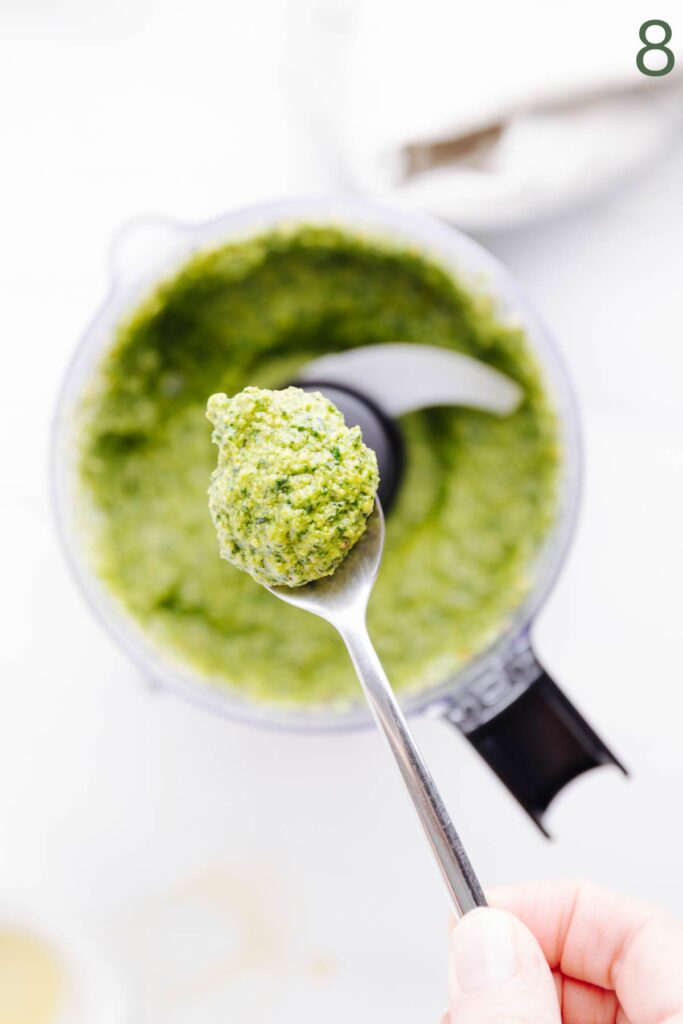
Step 9
Combine the cooked pasta and the basil pesto in a large bowl or pot.
Step 10
Toss until the pasta is evenly coated. Add 1-2 tablespoons of the pasta water if the pesto is too dry.
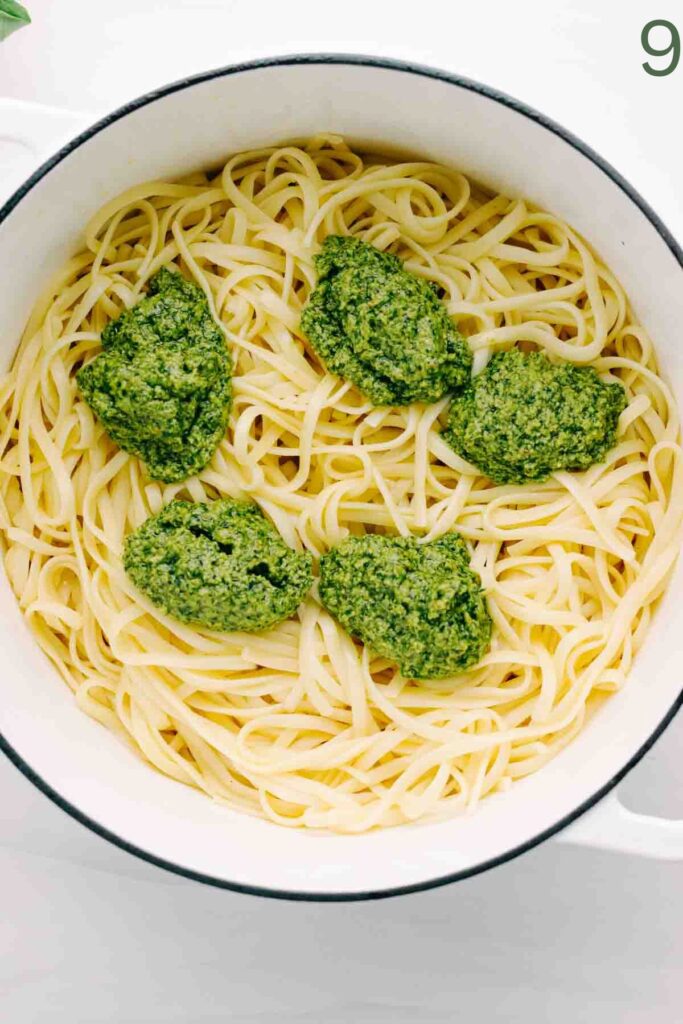
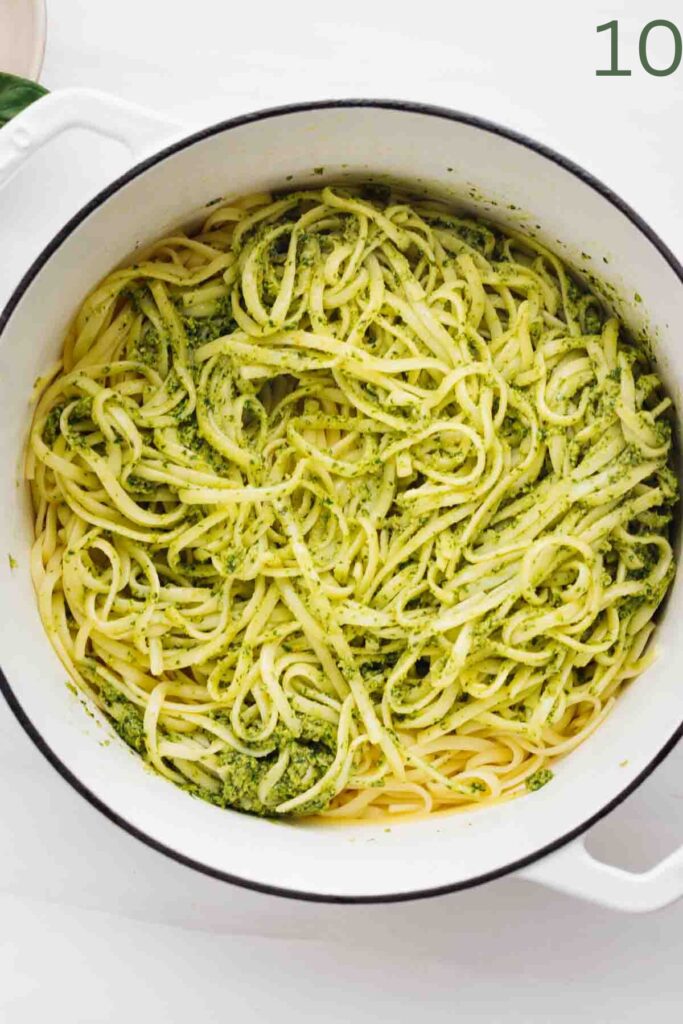
Garnish the pasta with basil leaves and nutritional yeast, if desired.
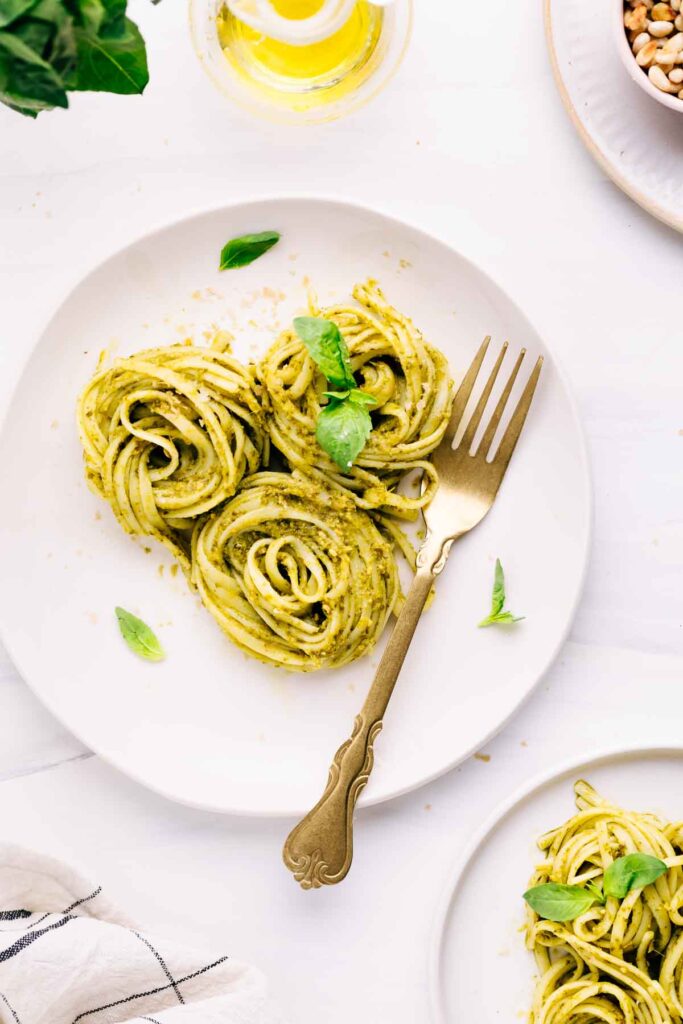
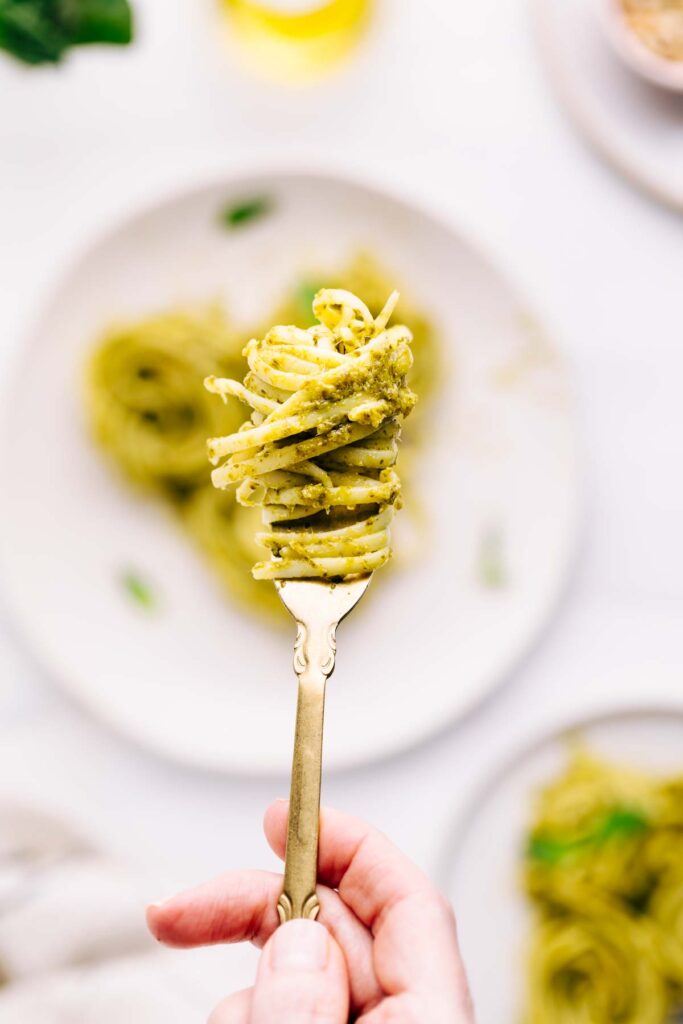
For the full recipe with the exact quantities of all the ingredients, see the recipe card.
VARIATIONS
There are some possible variations and substitutions if you don’t have all ingredients at hand or if you want to make this pasta dish even more exciting.
Pasta
This pasta recipe doesn’t have to be limited to just one type of pasta. Try using spaghetti, fettuccine, or penne for a change.
Herbs
You can switch it up and try a different herb for a non-basil pesto. Herbs with similar flavors are oregano, parsley, mint, sage, or tarragon. But greens like baby spinach or kale are also an option to experiment with.
Pine nuts
Pine nuts are costly. So, feel free to substitute those with roasted almonds, walnuts, sunflower seeds, cashews, pistachios, or blanched almonds.
Spice it up
Add red pepper flakes or more garlic to your pasta sauce if you like a little punch.
Creamier
To make it creamier, you can add vegan cream cheese or warm water-soaked and drained cashews to the food processor.
SUBSTITUTIONS
Customizing this Pasta Al Pesto recipe to cater to your taste is easy. Here are a few options to consider:
Pasta
Traditionally served with linguine, try spaghetti, penne, fettuccine, and tagliatelle, or go gluten-free with brown rice or quinoa pasta or low-carb with zucchini noodles or spaghetti squash.
Herbs
If fresh basil is unavailable, fresh mint or oregano can be used.
Nuts
For a nut-free version, use pumpkin seeds or sunflower seeds, or opt for a more economical option with walnuts, cashews, or almonds.
Olive oil
Olive oil can be swapped for avocado oil for a distinct flavor.
Garlic alternative
If garlic isn’t your thing, minced shallot or onion can be used instead.
Remember, altering ingredients will result in variations in the dish’s flavor profile.

EXPERT TIPS
These tips will guarantee the perfect plate of paste every time:
Textural perfection
The consistency of the pesto sauce should maintain a slightly coarse texture, not overly smooth like a smoothie. Over-processing the ingredients can lead to a too smooth texture and even diminish the flavor of the basil.
Furthermore, to preserve the unique basil flavor, do not heat the pesto either, just mix it with freshly cooked, hot pasta.
Quality matters
To achieve maximum flavor, use only the freshest basil leaves without brown spots and top-quality extra virgin olive oil.
Al dente pasta
Cook the pasta until tender (al dente). Overcooking the pasta can result in a mushy texture, so be mindful not to overdo it.
Garlic
To avoid clumps of garlic in your pesto, mince it before adding it to the food processor. Experiment with the amount of garlic – more for a garlicky flavor, less for a sweeter taste.
Thicken
The pasta cooking water is rich in starch, making it a great ingredient to thicken the pesto. Reserve 1/4 cup of the pasta cooking water before draining, and add it to the food processor with the pesto.
Technique
Mix the pesto until it is smooth and creamy, then spoon it over warm pasta for a well-coated, evenly absorbed flavor.
HOW TO STORE LEFTOVER PESTO
To store leftover homemade pesto, transfer it to an airtight container or jar with a tight-fitting lid. Place a layer of plastic wrap or wax paper directly on top of the pesto to prevent oxidation and browning. Moreover, to further protect it from air exposure, fill any extra space in the container with olive oil.
Pesto can be stored in the refrigerator for up to 7 days or in the freezer for up to 3 months if not used within that time.
FREQUENTLY ASKED QUESTIONS
Can I use a blender instead of a food processor?
A blender may not produce the same coarse and smooth texture, it can still be used to make pesto. Here are some tips:
- Mince the garlic to avoid garlic chunks in your pesto.
- Adding the oil gradually while blending the ingredients will help create a smoother texture.
- Use the pulse function on the blender to chop the ingredients, as this can create a smoothie-like texture.
- Consider using a small blender jar.
My pesto tastes boring. How can I enhance the flavors?
There are a few ways you can enhance the flavors of your pesto.
- Add more salt or Parmesan cheese.
- Roasting the garlic before adding it to the pesto creates a sweeter and milder flavor.
- Add freshly squeezed lemon juice to brighten its flavors.
- Add more basil.
Can I make this recipe nut-free?
Yes, if you are allergic to nuts, you can use sunflower seeds or pumpkin seeds as a replacement for pine nuts.
Are you craving more (pasta) recipes?
Did you love this recipe? Leave a comment & rate it!
⭐⭐⭐⭐⭐
I appreciate your feedback a lot and it also helps others.
Want to stay up to date with all new mouth-watering recipes? Subscribe to The Green Creator newsletter and follow The Green Creator on Instagram and Facebook.
Pasta Al Pesto Recipe
Print
Pasta Al Pesto (Linguine With Basil Pesto)
- Prep Time: 5
- Cook Time: 15
- Total Time: 20
- Yield: 2 1x
- Category: main dish, side
- Method: food processor
- Cuisine: Italian
- Diet: Vegan
Description
Pasta Al Pesto with homemade basil pesto is a classic Italian dish combining fresh basil, roasted pine nuts, olive oil, garlic, and nutritional yeast with al dente cooked linguine paste.
Ingredients
- 7 oz. (200 gr) linguine pasta
- 1 tsp salt (to boil the linguine with)
- ~ ½ cup (60 gr) pine nuts
- 2 cups (45 gr) loosely packed fresh basil leaves + a few leaves for serving
- 1 clove of garlic, minced (add more if you like a garlicky flavor)
- 2 tbsp (18 gr) nutritional yeast
- 1/4 tsp salt
- 1/4 tsp pepper
- ~ 1 1/4 tbsp (20 gr) vegan Parmesan cheese (optional)
- 6 tbsp (90 ml) extra-virgin olive oil
Instructions
- Bring a large pot of water with salt to a boil. Cook the linguine according to the package instructions until it is al dente. Reserve 1/4 cup of pasta water.
- Drain the pasta and set it aside (you can return it to the same pot).
- Add the pine nuts to a dry pan and roast until most of the pine nuts turn brown. Keep an eye on the pan, as pine nuts tend to burn quickly. Give the pan a shake often to prevent the pine nuts from burning.
- While the pasta is cooking, make the pesto. In a food processor, pulse together basil, garlic, pine nuts, nutritional yeast, vegan Parmesan cheese, salt, and pepper until it is semi-smooth. Blend the ingredients until they are well combined, and slowly add the olive oil.
- If the pesto is too thick and dry, add a little pasta water to thin it out. It should be smooth with a bit of texture.
- Add the pesto to the pot with cooked linguine and toss until the pasta is evenly coated. If the pasta seems dry, add a little of the reserved pasta water, a tablespoon at a time, until the desired consistency is reached.
- Taste the pesto before serving and adjust the seasoning according to your taste. You may need to add more salt or pepper to enhance the flavors.
- Serve the pesto pasta immediately, garnished with basil leaves, nutritional yeast (or vegan Parmesan cheese), and a sprinkle of black pepper, if desired.
Equipment
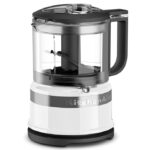 Buy Now →
Buy Now → Notes
- Store
Store pesto in an airtight container or jar with a tight-fitting lid. Add plastic wrap on top and fill extra space with olive oil. Keep in the refrigerator for up to 7 days. - Freeze
If you are not going to use it within that time, consider freezing it in ice cube trays or small containers for up to 3 months. - Serving portions
Italian guidelines recommend 100 grams (3-1/2 ounces) or less of uncooked/dried pasta or less for 1 serving per person. - Don’t over-process the pesto
Keep pesto slightly coarse for a bold basil flavor. Over-processing can heat it and weaken the flavors. So, avoid excessive blending. - Garlic
Crush the garlic when adding to the food processor to avoid clumps of garlic in your pesto. - Warm pasta
Combine pesto with warm, freshly cooked al dente pasta. Cold pasta becomes hard and makes mixing with pesto more difficult.
Nutrition
- Serving Size: 2
- Calories: 974
- Sugar: 2.7g
- Fat: 63.4g
- Carbohydrates: 84.6g
- Fiber: 8.4g
- Protein: 22.2g
The links mentioned in the text are affiliate links, indicated by being underlined and bold.









Made this last night as I had all the ingredients at hand (minus the Parmesan) and it was delicious. Leftover pesto today for lunch was also good on a sandwich! Thank you!
That was absolutely scrumptious thx
Thank you Charlie!